Urinary Tract Infection in Children
Return to Overview PageDefinition & Facts
In this section:
- What is a bladder infection?
- Is there another name for a bladder infection?
- How common are bladder infections in children?
- Which children are more likely to develop a bladder infection?
- What are the complications of bladder infections in children?
What is a bladder infection?
A bladder infection is an illness that is usually caused by bacteria. Bladder infections are the most common type of urinary tract infection (UTI) in children. A UTI can develop in any part of your child’s urinary tract, including the urethra, bladder, ureters, or kidneys.
All healthy children have some bacteria on their bodies and in their bowels. Occasionally, bacteria can get into the bladder and start an infection. Children of any age can and do develop bladder infections, including infants.
Your child’s body has ways to defend against infection. For example, urine normally flows from your child’s kidneys, through the ureters, to the bladder. Bacteria that enter the urinary tract are flushed out when your child urinates. This one-way flow of urine keeps bacteria from infecting the urinary tract.
Sometimes the body’s defenses fail and the bacteria cause a bladder infection. If your child has symptoms of a bladder infection, or has a fever without a clear cause, see a health care professional within 24 hours.
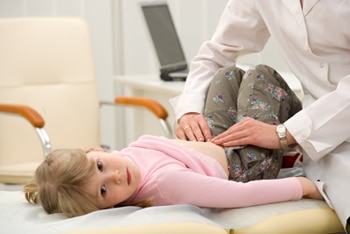
Getting treatment right away for an infection in your child’s urethra or bladder can prevent a kidney infection. A kidney infection can develop from an infection that moves upstream to one or both kidneys. Kidney infections are often very painful and can be dangerous and cause serious health problems, so it’s best to get early treatment when your child has a bladder infection.
A health care professional is likely to treat your child’s bladder infection with antibiotics, a type of medicine that fights bacteria. It’s important for your child to take every dose on time and to finish all of the medicine.
Is there another name for a bladder infection?
Bladder infections are also called cystitis. Sometimes people use the more general term, urinary tract infection (UTI) to mean a bladder infection, although UTIs can occur in other parts of the urinary system. A UTI that affects the kidneys is called pyelonephritis.
How common are bladder infections in children?
Bladder infections are a common reason that children visit a health care professional. Each year, about 3 in 100 children develop a UTI, and most of these infections are bladder infections.1
- Babies under 12 months old are more likely to have a UTI than older children.
- During the first few months of life, UTIs are more common in boys than girls.
- By age 1, girls are more likely to develop a UTI than boys—and girls continue to have a higher risk throughout childhood and the teen years.2
Which children are more likely to develop a bladder infection?
Girls are much more likely to develop bladder infections than boys, except during the first year of life. Among boys younger than age 1, those who have not had the foreskin of the penis removed, called a circumcision, have a higher risk for a bladder infection. Still, most uncircumcised boys will not get a bladder infection.
In general, any condition or habit that keeps urine in your child’s bladder for too long may lead to an infection.
Other factors that may make your child more likely to develop a bladder infection include
- abnormal bladder function or habits, such as
- overactive bladder—a treatable condition that often goes away as your child grows older
- not emptying the bladder fully
- waiting too long to urinate
- constipation—fewer than two bowel movements a week or hard bowel movements that are painful or difficult to pass
- vesicoureteral reflux (VUR)—the backward flow of some urine from the bladder toward the kidneys during urination.
- urinary blockage—a problem that limits the normal flow of urine, such as a kidney stone or a ureter that is too narrow. In some cases, this can be related to a birth defect.
- poor toilet hygiene
- family history of UTIs
Among teen girls, those who are sexually active are more likely to get a bladder infection.
Different anatomy makes girls much more likely to develop a bladder infection than boys:
- Girls have a shorter urethra than boys, so bacteria don’t have to go as far to reach the bladder and cause an infection.
- In girls, the urethra is closer to the anus, a source of bacteria that can cause a bladder infection.
What are the complications of bladder infections in children?
Quick treatment is likely to cure your child’s bladder infection with no complications.
If an infection in the lower urinary tract, such as a bladder infection, is not treated properly, it can lead to a kidney infection. Kidney infections that last a long time or keep coming back can cause damage to a child’s kidneys that never goes away. This damage can include kidney scars, poor kidney function, high blood pressure, and problems during pregnancy. Young children have a greater risk for kidney damage from a UTI than older children and adults.
In a few cases, a kidney infection can develop suddenly and become life-threatening, particularly if bacteria get into the bloodstream, which causes a reaction called sepsis, or septicemia.
References
Symptoms & Causes
What are the symptoms of a bladder infection?
Don’t assume that you’ll know when your child has a bladder infection, even if you’ve had one yourself. Symptoms can be very different in children than in adults, especially for infants and preschoolers. If your child is not well, contact your child’s pediatrician or health clinic.
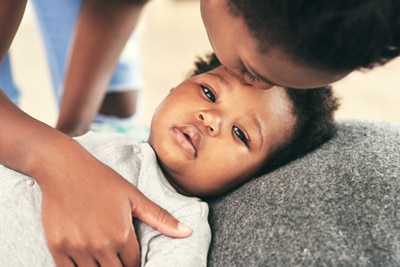
Young children
It’s not always obvious when an infant or child younger than age 2 has a bladder infection. Sometimes there are no symptoms. Or, your child may be too young to be able to explain what feels wrong. A urine test is the only way to know for certain whether your child has a bladder or kidney infection.
When a young child has symptoms of a UTI, they may include
- fever, which may be the only sign
- vomiting or diarrhea
- irritability or fussiness
- poor feeding or appetite; poor weight gain
Older children
Symptoms of a bladder or kidney infection in a child ages 2 and older can include
- pain or burning when urinating
- cloudy, dark, bloody, or foul-smelling urine
- frequent or intense urges to urinate
- pain in the lower belly area or back
- fever
- wetting after a child has been toilet trained
Seek care right away
If you think your child has a bladder infection, take him or her to a health care professional within 24 hours. A child who has a high fever and is sick for more than a day without a runny nose, earache, or other obvious cause should also be checked for a bladder infection. Quick treatment is important to prevent the infection from getting more dangerous.
What causes a bladder infection?
Most often a bladder infection is caused by bacteria that are normally found in the bowel. The bladder has several systems to prevent infection. For example, urinating most often flushes out bacteria before it reaches the bladder. Sometimes, your child’s body can’t fight the bacteria and the bacteria cause an infection. Certain health conditions can put children at risk for bladder infections.
Diagnosis
How do health care professionals diagnose a bladder infection?
Health care professionals use your child’s medical history, a physical exam, and tests to diagnose a bladder infection.
A health care professional will ask about health conditions that may make your child more likely to develop a bladder infection.
During a physical exam, the health care professional will also ask about your child’s symptoms.
What tests do health care professionals use to diagnose a bladder infection?
Health care professionals typically test a urine sample, which is called urinalysis, to help to diagnose a bladder infection. A urine culture, which takes longer to come back from the lab, is needed for an accurate diagnosis. In some cases, a health care professional may order more tests to look at your child’s urinary tract.
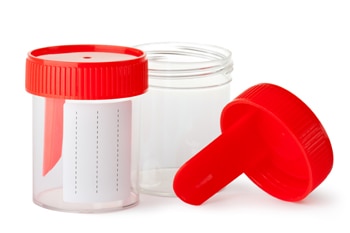
Lab tests
Urinalysis. A small amount of your child’s urine must be collected for this test. Babies and small children who are not toilet trained will have a small, thin, flexible tube called a catheter placed into the urethra to get a urine sample. This is needed because urine from collection bags, which can be taped around a baby’s diaper area, is often contaminated, or mixed, with germs and other substances found on the baby’s skin. If urine is contaminated, test results will not be accurate.
Parents may help preschoolers catch a clean urine sample in a special container, and older children and teens can do it by themselves.
A health care professional will look at the sample under a microscope for bacteria and white blood cells, which the body produces to fight infection. Bacteria also can be found in the urine of healthy children, so a bladder infection is diagnosed based on both your child’s symptoms and lab test results.
Urine culture. A health care professional must order a urine culture to find out what type of bacteria is causing your child’s infection. Lab workers will monitor how the bacteria multiply, usually over 1 to 3 days, to help determine the best treatment for your child.
Imaging tests
A health care professional may order imaging tests to find the cause of your child’s infection or to check for kidney damage.
Ultrasound. An ultrasound uses specialized sound waves to look at structures inside the body without exposing your child to radiation. During this painless test, your child lies on a padded table. A technician gently moves a wand called a transducer over your child’s belly and back. Ultrasound can create images of your child’s entire urinary tract. No anesthesia is needed.
Ultrasound may be recommended if your child
- is younger than age 2 and has a bladder infection with a fever
- has had repeated bladder infections at any age
- has high blood pressure, poor growth, or a family history of kidney or bladder problems
- doesn’t get better with treatment
An ultrasound may be scheduled right away or a few weeks or months after your child’s illness has passed.
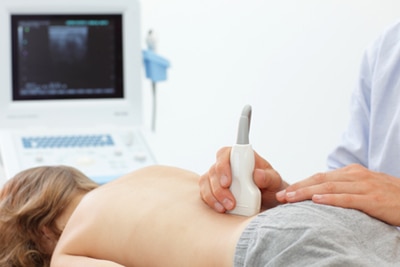
Voiding cystourethrogram (VCUG). A voiding cystourethrogram uses x-rays of the bladder and urethra to show how urine flows. A catheter is used to fill your child’s bladder with a special dye. Then x-ray pictures are taken before and after your child urinates. A VCUG can show if urine flows backward from the bladder into the ureters or kidneys, a condition called vesicoureteral reflux (VUR). Anesthesia is not needed for this test, but your child may be offered a calming medicine, called a sedative.
Treatment
How do health care professionals treat bladder infections in children?
Bladder infections in children are treated with antibiotics, a type of medicine that fights bacteria.
Medicines
Which antibiotic your child takes is based on age, any allergies to antibiotics, and the type of bacteria causing the UTI. Children older than 2 months usually take an antibiotic by mouth—as a liquid or as a chewable tablet.
Your child may go to a hospital for intravenous (IV) antibiotics if the child is younger than 2 months old or vomiting. IV medicines are given through a vein.
Your child should start to feel better within a day or two, but it’s important to take every dose of the antibiotic on time and to finish all the medicine. The infection could come back if your child stops taking the antibiotic too soon.
The length of treatment depends on
- how severe the infection is
- whether a child’s symptoms and infection go away
- whether a child has repeated bladder infections
- whether the child has vesicoureteral reflux or another problem in the urinary tract
At-home treatments
Children should drink plenty of liquids and urinate often to speed healing. Drinking water is best. Ask your health care professional how much liquid your child should drink.
A heating pad on a child’s back or abdomen may help ease pain from a kidney or bladder infection.
How can I help my child prevent a bladder infection?
Drinking enough liquids, following good bathroom and diapering habits, wearing loose-fitting clothes, and getting treated for related health problems may help prevent a UTI in a child or teen.
Be sure your child drinks enough liquids
Drinking more liquids may help flush bacteria from the urinary tract. Talk with a health care professional about how much liquid your child should drink, and which beverages are best to help prevent a repeat UTI.
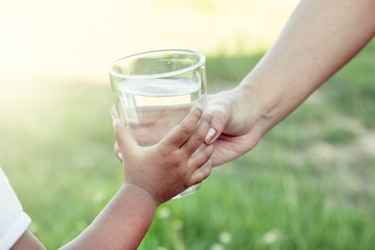
Follow good bathroom and diapering habits
Some children simply don’t urinate often enough. Children should urinate often and when they first feel the need to go. Bacteria can grow and cause an infection when urine stays in the bladder too long. Caregivers should change diapers often for infants and toddlers, and should clean the genital area well. Gentle cleansers that do not irritate the skin are best.
Your child should always wipe from front to back after urinating or having a bowel movement. This step is most important after a bowel movement to keep bacteria from getting into the urethra and bladder.
Avoid constipation
Hard stools can press against the urinary tract and block the flow of urine, allowing bacteria to grow. Helping your child have regular bowel movements can prevent constipation.
Wear loose-fitting clothing
Consider having children wear cotton underwear and loose-fitting clothes so air can keep the area around the urethra dry.
Treat related health problems
When a child’s bladder doesn’t work exactly as it should—called dysfunctional voiding—treatments may help the bladder work better and prevent repeated infections. The muscles that control urination may be out of sync. Or, your child’s bladder may be overactive or underactive.
Health care professionals can treat these types of bladder problems with medicines, behavior changes, or both. Children often grow out of these bladder problems naturally over time.
If your child has vesicoureteral reflux, a urinary tract blockage, or an anatomical problem, see a pediatric urologist or other specialist. Treating these conditions may help prevent repeated bladder infections.
Diabetes and other health conditions can increase the risk for a bladder infection. Ask your child’s health care professional how to reduce the risk of developing a bladder infection.
Eating, Diet, & Nutrition
Can my child’s eating, diet, or nutrition help prevent a bladder infection?
Food doesn’t play a role in preventing or treating bladder infections in children. Some research suggests that cranberry products such as juice, extracts, or pills may help prevent these infections in children, but there’s not enough evidence to be certain. Cranberry products are not an effective treatment once your child already has a bladder infection.3
Children who may have a bladder infection should see a health care professional right away for diagnosis and treatment. Cranberry products should not replace medical treatment.
Can drinking liquids help prevent or relieve a bladder infection?
Yes. Check with a health care professional about how much liquid your child should drink to prevent or relieve a bladder infection. The amount will depend on your child’s size, age, and activity level, as well as the weather. If your child lives in a hot climate and is active, he or she may need more liquid to replace fluid lost through sweat.
References
Clinical Trials
The National Institute of Diabetes and Digestive and Kidney Diseases (NIDDK) and other components of the National Institutes of Health (NIH) conduct and support basic and clinical research into many diseases and conditions.
What are clinical trials and what role do children play in research?
Clinical trials are research studies involving people of all ages. Clinical trials look at safe and effective new ways to prevent, detect, or treat disease. Researchers also use clinical trials to look at other aspects of care, such as improving quality of life. Research involving children helps scientists
- identify care that is best for a child
- find the best dose of medicines
- find treatments for conditions that only affect children
- treat conditions that behave differently in children
- understand how treatment affects a growing child’s body
Find out more about clinical trials and children.
Watch a video of NIDDK Director Dr. Griffin P. Rodgers explaining the importance of participating in clinical trials.
What clinical trials are open?
Clinical trials that are currently open and are recruiting can be viewed at www.ClinicalTrials.gov.
This content is provided as a service of the National Institute of Diabetes and Digestive and Kidney Diseases
(NIDDK), part of the National Institutes of Health. NIDDK translates and disseminates research findings to increase knowledge and understanding about health and disease among patients, health professionals, and the public. Content produced by NIDDK is carefully reviewed by NIDDK scientists and other experts.
The NIDDK would like to thank:
Saul P. Greenfield, MD, FAAP, FACS, State University of New York at Buffalo School of Medicine; Jeffrey M. Saland, MD, MSCR, Icahn School of Medicine at Mt. Sinai

